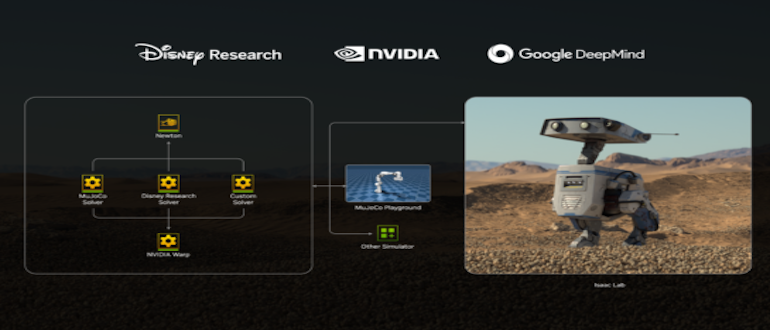
Amid an avalanche of artificial intelligence (AI) announcements Tuesday, NVIDIA Corp. said it is teaming with Walt Disney Co. and Alphabet Inc.’s Google DeepMind on entertainment robots.
Disney will be among the first to benefit from the fruits of Newton, a physics engine to simulate robotic movements in real-world settings.
The entertainment giant’s Disney Research unit plans to use the technology to undergird its next-generation entertainment robots such as the Star Wars-inspired BDX droids at its theme parks, starting in 2026.
“The BDX droids are just the beginning. We’re committed to bringing more characters to life in ways the world hasn’t seen before, and this collaboration with Disney Research, NVIDIA, and Google DeepMind is a key part of that vision,” Kyle Laughlin, senior vice president of Walt Disney Imagineering Research and Development, said in a blog post. “This collaboration will allow us to create a new generation of robotic characters that are more expressive and engaging than ever before — and connect with our guests in ways that only Disney can.”
An early open source version of Newton should be ready later this year, NVIDIA CEO Jensen Huang revealed at the company’s GTC developers conference in San Jose, Calif.
Disney has discussed the idea of Star Wars-like droids at its parks for years and has offered several demos, including one at the SXSW show in Austin, Texas, this month.
On Tuesday, NVIDIA debuted GROOT N1, an AI foundation model for humanoid robots that it says lets machines better perceive and reason in their surroundings.
Newton, in turn, enables robots to be more “expressive” and “learn how to handle complex tasks with greater precision,” according to NVIDIA. The physics engine is highly customizable, allowing developers to program robotic interactions with food, sand and cloth, NVIDIA said.
NVIDIA’s robot news comes amid another AI breakthrough of sorts for the fledgling industry. In what it claims is one of the first instances of physical agentic AI, Swedish AI startup IntuiCell said Wednesday that it has created Luna, a robot dog with a functional digital nervous system capable of learning and adapting like humans and animals.
IntuiCell said it will hire a dog trainer instead of using Generative AI and vast datasets to teach Luna to walk based on how neurons interact and process information. Luna can currently stand on its feet.
“What we have built is the first software that allows any machine to learn like humans and animals do,” company CEO and co-founder Viktor Luthman told Reuters.
“The next step is exploring humanoid robotics, exploring autonomous robotics in unpredictable environments such as space exploration, deep sea exploration, or disaster response,” he added.
Meanwhile, University of California, Berkeley, biologists and engineers say they have developed a robotic squirrel that can stick a landing on a narrow perch after studying the biomechanics of squirrel leaps and landings.

